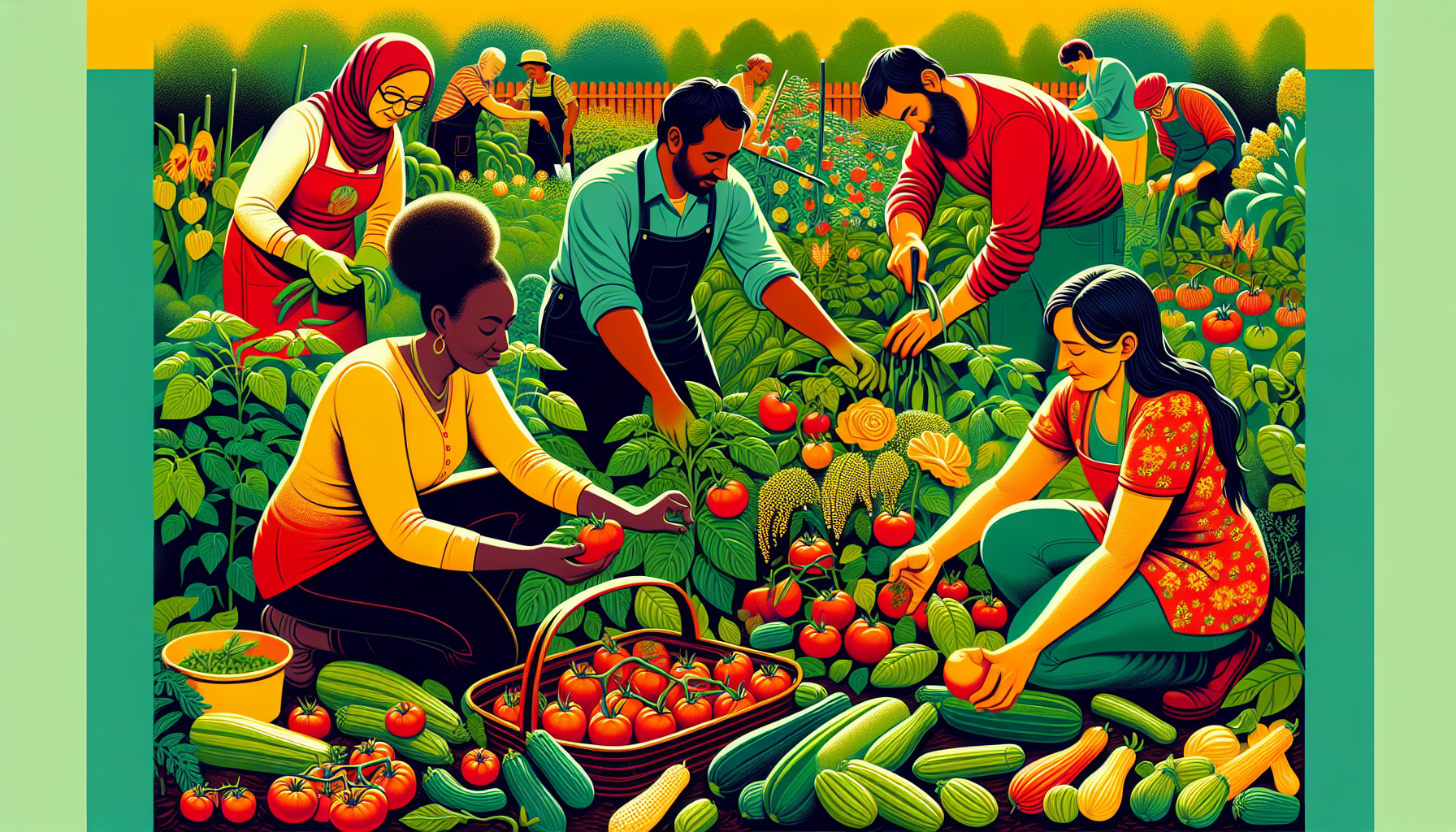Empower Lives: Innovative Ways to Feed the Poor
Empower Lives: Innovative Ways to Feed the Poor
Want to feed the poor? Discover actionable steps and innovative ideas within this essential guide for those eager to make a tangible impact. Learn how to dive into food bank volunteering, initiate community gardens, leverage technology, and more, as we explore comprehensive strategies to not just feed but empower those in need.
Key Takeaways
-
Innovative local initiatives such as food banks, community gardens, and meal distribution programs are essential in fighting hunger and fostering community solidarity.
-
Technology plays a crucial role in combating hunger through apps for food sharing, online platforms enhancing food drive reach, and data analytics for identifying high-need areas.
-
Nutritional education, job training, healthcare access, and housing assistance are vital components of a holistic approach to combating poverty and hunger, aiming for lasting impacts on food security and overall well-being.
Alleviating Hunger Through Direct Action

One of the most direct ways to combat hunger is through direct action. Organizations like Feed My Poor and Crossroads Community Baptist Church show us the power of direct action in feeding the hungry. They not only provide meals but also foster community solidarity and resilience through innovative methods like recovering surplus ‘ugly’ produce that would otherwise go to waste and offering cold water to those in need.
Volunteering at Food Banks
Food banks are at the forefront of this fight against hunger, serving as vital lifelines for those in need. But these places rely heavily on the generosity of volunteers who sort, pack, and distribute food.
The simple act of volunteering at a food bank can create a ripple effect, touching countless lives and filling not just bellies but also hearts with hope. With a bountiful eye, one can see the impact of their actions on the community’s life.
Initiating Community Gardens

Community gardens are another innovative approach to alleviate hunger. They not only yield fresh produce for those in need but also sow seeds of social interaction and community cohesion. Plus, being involved in a community garden can be a therapeutic experience, reducing stress and increasing happiness.
It’s not just about growing food, but also about nurturing communities and connections.
Joining Meal Distribution Efforts
Meal distribution programs are another effective way to address hunger at a community level. By supporting existing programs or initiating new ones, individuals can make a direct impact and address community-specific hunger issues.
It’s about delivering not just a meal, but also a message of hope and solidarity.
The Role of Technology in Combating Hunger

In our digital age, technology has become a powerful ally in the fight against hunger. Here are some ways technology is helping us address the problem of hunger:
-
Mobile apps that connect food donors with recipients
-
Online platforms that enhance the reach of food drives
-
Data analytics tools that help identify areas of high need
-
Online fundraising platforms that make it easy to donate to hunger relief organizations
-
Social media campaigns that raise awareness and encourage action
Technology is enabling us to tackle the age-old problem of hunger in new and innovative ways, ultimately improving human life.
Apps for Food Sharing
Food sharing apps like ‘Too Good To Go’, ‘Olio’, and ‘Karma’ are reducing food waste and ensuring that surplus items reach those who need them most. These apps not only help feed the hungry but also promote a culture of sharing and community among users.
Online Platforms for Food Drives
Online platforms are another innovative tool in the fight against hunger. They provide tools for resource gathering and distribution, enhancing the efficiency and reach of community-organized food drives. In this way, they help mobilize community support and resources to combat hunger.
Fostering Hope Through Nutritional Education
While providing food is crucial, it’s equally important to educate individuals about nutrition. Nutritional education helps people make informed food choices, improve their dietary habits, and ultimately, enhance their overall well-being. It’s especially important for populations struggling with food insecurity, where inadequate nutrition can have serious health consequences.
Workshops for Healthy Eating
Educational workshops play a crucial role in teaching low-income families how to prepare affordable and nutritious meals. Programs like Home Plate and WIC offer classes and counseling that focus on developing the skills needed for healthy home cooking. It’s about empowering individuals with knowledge, so they can make the most of the food they have.
Educational Resources for Diet Planning
Resources like ‘Healthy Eating on a Budget’ from the United States Department of Agriculture assist with meal planning and grocery shopping within a limited budget. They offer practical tools like grocery and pantry lists and feature recipes that align with the Dietary Guidelines for Americans.
These resources not only help families eat healthier but also stretch their food dollars further.
Building a Compassionate Community
In the fight against hunger, building a compassionate community is paramount. From organizing local fundraisers to launching awareness campaigns, communities play a crucial role in addressing hunger.
By fostering unity and a sense of shared responsibility, communities can become powerful agents of change.
Organizing Local Fundraisers
Local fundraisers are a key strategy in gathering resources for hunger relief efforts. Whether it’s a charity run, a bake sale, or a themed event, fundraisers can rally community support and resources to combat hunger. They not only collect vital supplies for food banks but also foster a sense of unity and shared responsibility.
Creating Awareness Campaigns
Raising awareness about the prevalence of hunger is another crucial aspect of community involvement. Through educational events, social media engagement, and interfaith dialogues, communities can inform and encourage their members to contribute to hunger relief efforts.
It’s about shedding light on the issue of hunger and inspiring action.
Transformative Charity: More Than Just a Meal

Charity goes beyond providing meals. It’s about transforming lives and empowering individuals towards self-sufficiency. This is where job training programs, access to healthcare, and housing assistance come into play.
Holistic livelihood programs that combine these elements can significantly enhance food security and overall well-being for low-income families.
Job Training Programs
Job training programs can be a game-changer for poor people, lifting many a curse that has held them back, including those faced by a poor brother. By equipping them with the skills they need for gainful employment, these programs empower individuals towards self-sufficiency, acting as a guiding lord in their journey as a poor man.
Organizations like FareStart are leading the way in this regard, offering comprehensive support services with a focus on food service and culinary arts employment.
Access to Health Care
Access to healthcare is another critical aspect of transformative charity. Nutritional programs, such as those offered by WIC, not only improve nutrition and overall health but also facilitate access to medical services for impoverished populations. In this way, they contribute to healthier communities and reduce the burden on healthcare systems.
Housing Assistance Efforts
Addressing homelessness is as important as addressing hunger. Recognizing the interconnected nature of these issues, organizations offer comprehensive support that includes shelter information, veterans housing assistance, and guidance for those at risk of becoming homeless. By addressing homelessness, they not only help individuals find a roof over their heads but also provide them with a sense of security and stability.
Faith in Action: Religious Communities Feeding the Hungry

Religious communities across the world, including those that follow the Bible and believe in the Lord God, have long been involved in feeding the hungry. Whether it’s through church-organized soup kitchens or interfaith collaborations, these communities exemplify the spirit of service and compassion, reaching out to those in need regardless of their faith or background. In fact, it is said that Jesus heard the cries of the hungry and responded with love and care.
Church-Organized Soup Kitchens
Church-operated soup kitchens have been a beacon of hope for many. They offer more than just a warm meal; they provide a space of fellowship and community, where everyone is welcomed with open arms. These soup kitchens embody the spirit of charity, serving as a reminder of the power of compassion and community in alleviating hunger.
Interfaith Collaborations for Hunger Relief
Interfaith collaborations offer a unique platform where various religious communities unite to address hunger. Events like Catholic Charities’ Kaleidoscope in Nashville are testament to the power of such collaborations. They not only provide hunger relief but also foster intercultural dialogue and understanding, building compassionate and inclusive communities committed to addressing hunger.
A Global Perspective: International Aid and Feeding Programs
When it comes to addressing hunger, a global perspective is essential. International aid and feeding programs play a crucial role in this regard, combining immediate food aid with sustainable solutions like nutrition education and support for agriculture.
Organizations like Food For The Poor (FFTP) are leading the way in this regard, demonstrating how a holistic approach can create lasting solutions.
Sustainable Agriculture Projects
In the fight against global hunger, sustainable agriculture projects hold the key. From regenerative agriculture to food processing innovations, these projects utilize innovative technologies to enhance food security and agricultural sustainability. They not only increase food production but also contribute to economic empowerment and fair trade, bringing benefits to both producers and consumers worldwide.
Emergency Food Aid
Emergency food aid is a lifeline for millions of people in crisis situations worldwide. Organizations like USAID’s Bureau for Humanitarian Assistance specialize in this area, supporting over 60 million people across nearly 60 countries each year.
Through strategies like the distribution of direct food aid, cash transfers, or food vouchers, they provide timely and effective aid to those in crisis situations.
Summary
In conclusion, feeding the poor is more than just providing meals; it’s about empowering individuals, building compassionate communities, and creating sustainable solutions. It’s about leveraging technology, fostering nutritional education, and cultivating a spirit of service and unity. As we continue to innovate and collaborate, we move closer to our shared vision of a hunger-free world.
Frequently Asked Questions
What roles can volunteers play at food banks?
Volunteers can play important roles at food banks by sorting and packing food, as well as distributing meals within the community. Joining a local food bank and offering your time can make a real difference in addressing food insecurity in your area.
How do food-sharing apps help reduce food waste?
Food-sharing apps help reduce food waste by connecting donors with those in need, ensuring surplus food reaches those who need it most. This helps address food waste effectively.
How can educational workshops help low-income families?
Educational workshops can help low-income families by teaching them how to prepare affordable and nutritious meals, empowering them with the knowledge and skills needed for healthy home cooking. This can have a positive impact on their overall well-being.
What services do job training programs offer?
Job training programs offer individuals the skills needed for gainful employment, empowering them towards self-sufficiency.
How do sustainable agriculture projects enhance food security?
Sustainable agriculture projects enhance food security by increasing food production and agricultural sustainability through innovative technologies and initiatives.
